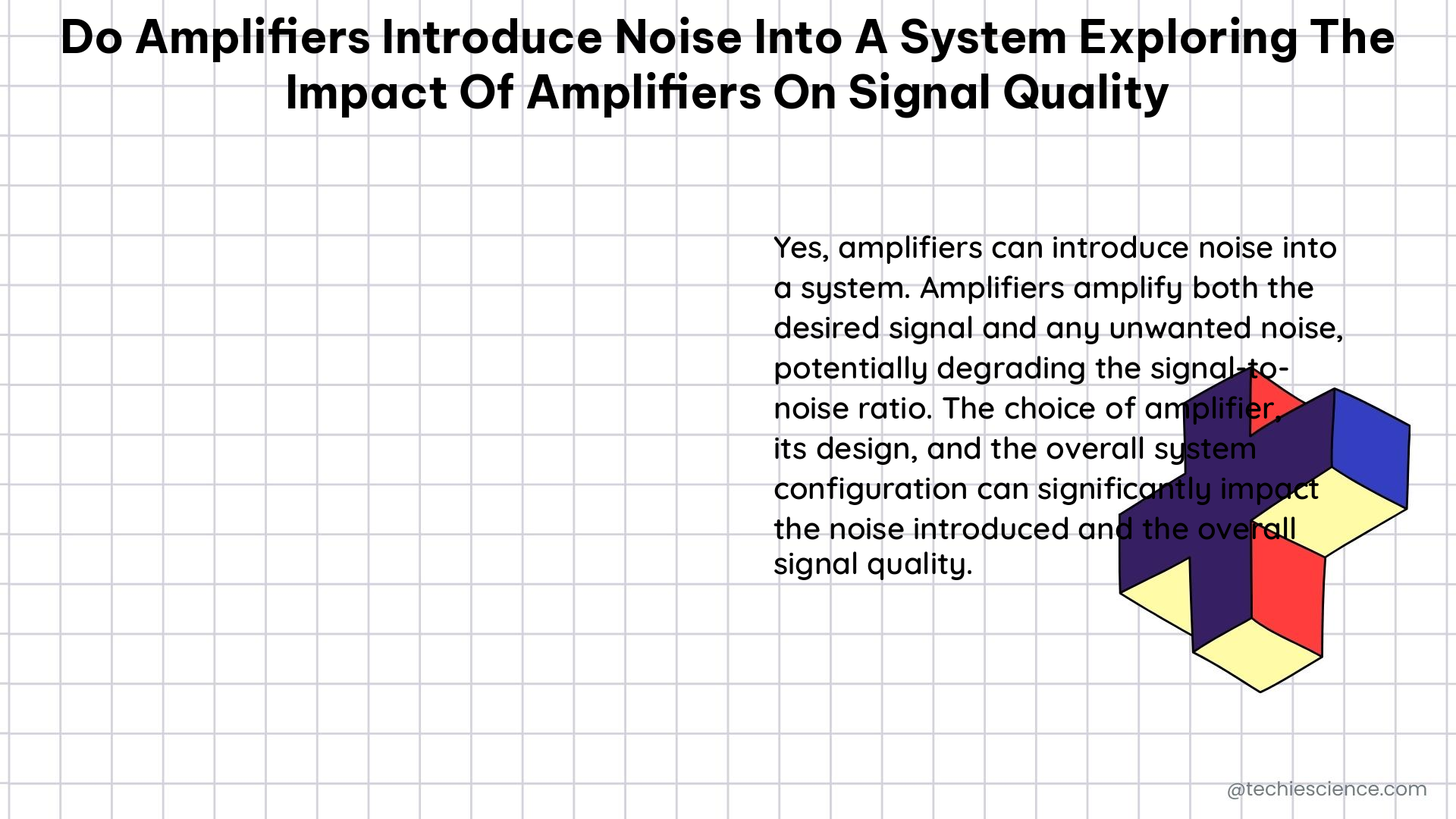Amplifiers are essential components in many electronic systems, from audio equipment to communication networks. However, the introduction of noise by amplifiers can have a significant impact on the overall signal quality, potentially degrading the performance of the entire system. In this comprehensive blog post, we will delve into the intricacies of how amplifiers can introduce noise and explore the various factors that contribute to this phenomenon.
Understanding Noise in Amplifiers
Noise in amplifiers can be attributed to several sources, including thermal noise, shot noise, and flicker noise. Thermal noise, also known as Johnson-Nyquist noise, is generated by the random motion of charge carriers in the resistive elements of the amplifier. This noise is proportional to the absolute temperature and the bandwidth of the system. Shot noise, on the other hand, is caused by the random arrival of charge carriers at a barrier, such as a p-n junction, and is proportional to the square root of the current. Flicker noise, or 1/f noise, is generated by the random fluctuations of the current in a conductor and is inversely proportional to the frequency.
Quantifying Noise in Amplifiers

To measure and quantify the noise introduced by an amplifier, engineers use several figures of merit, including noise figure, noise factor, and noise temperature.
Noise Figure (NF)
Noise figure is a measure of the signal-to-noise ratio (SNR) degradation that an amplifier introduces. It is defined as the ratio of the output SNR to the input SNR, expressed in decibels (dB). A lower noise figure indicates better noise performance. For example, a noise figure of 2 dB means that the amplifier degrades the SNR by 2 dB.
Noise Factor (F)
Noise factor is another measure of an amplifier’s noise performance. It is defined as the ratio of the total output noise power to the noise power delivered to the input terminals of the amplifier, when the amplifier is terminated with a resistance equal to its input impedance. Noise factor is also expressed in decibels.
Noise Temperature (Tn)
Noise temperature is a measure of the noise power contributed by an amplifier, referenced to a standard temperature of 290 Kelvin. It is expressed in degrees Kelvin. A lower noise temperature indicates better noise performance.
Measuring Noise in Amplifiers
The noise contribution from an amplifier can be measured directly using available test equipment, such as a spectrum analyzer or a noise figure meter. These instruments can measure the noise power spectral density (PSD) of the amplifier output and calculate the noise figure or noise factor based on the input signal level and the amplifier gain.
Spectrum Analyzer
A spectrum analyzer is a powerful tool for measuring the noise performance of an amplifier. It can provide a detailed view of the noise power distribution across the frequency spectrum, allowing engineers to identify specific noise sources and their impact on the overall signal quality.
Noise Figure Meter
A noise figure meter is a specialized instrument designed to directly measure the noise figure of an amplifier. It typically includes a calibrated noise source and a receiver that can accurately determine the noise figure based on the input and output signal levels.
Factors Affecting Noise in Amplifiers
In addition to the noise introduced by the amplifier itself, other factors can also contribute to the overall noise in a system. These include:
- Thermal Noise: Thermal noise is generated by the random motion of charge carriers in a conductor and is proportional to the absolute temperature.
- Shot Noise: Shot noise is generated by the random arrival of charge carriers at a barrier, such as a p-n junction, and is proportional to the square root of the current.
- Flicker Noise: Flicker noise, also known as 1/f noise, is generated by the random fluctuations of the current in a conductor and is inversely proportional to frequency.
- External Noise Sources: External noise sources, such as electromagnetic interference (EMI) or radio frequency interference (RFI), can also degrade the signal quality if not properly addressed.
Minimizing Noise in Amplifier-Based Systems
To minimize the impact of noise on signal quality, it is essential to carefully design and optimize the amplifier and the overall system. This may involve:
- Component Selection: Choosing amplifier components with low noise figures, such as low-noise transistors or operational amplifiers, can significantly improve the noise performance of the system.
- Shielding and Filtering: Implementing effective shielding and filtering techniques can help reduce the impact of external noise sources on the system.
- Signal Routing and Termination: Carefully routing and terminating signal lines can minimize the introduction of noise through capacitive and inductive coupling.
- Thermal Management: Maintaining a stable and controlled temperature environment can help reduce the impact of thermal noise on the system.
- Feedback and Compensation: Employing feedback and compensation techniques, such as negative feedback or noise cancellation, can help mitigate the effects of amplifier noise.
Conclusion
Amplifiers can indeed introduce noise into a system, which can have a significant impact on signal quality. Understanding the sources of noise, quantifying its impact, and implementing effective noise-reduction strategies are crucial for designing high-performance electronic systems. By carefully considering the factors that contribute to noise in amplifiers, engineers can optimize the design and ensure that the signal quality is maintained throughout the system.
Reference Links:
- Tektronix. (2021). Noise Figure: Overview of Noise Measurement Methods. Retrieved from https://www.tek.com/en/documents/whitepaper/noise-figure-overview-noise-measurement-methods
- Electronic Design. (2007). A Quick Guide to Signal Quality. Retrieved from https://www.electronicdesign.com/technologies/test-measurement/article/21201462/a-quick-guide-to-signal-quality
- diyAudio. (2019). Measuring Signal to Noise Ratio. Retrieved from https://www.diyaudio.com/community/threads/measuring-signal-to-noise-ratio.340909/

The lambdageeks.com Core SME Team is a group of experienced subject matter experts from diverse scientific and technical fields including Physics, Chemistry, Technology,Electronics & Electrical Engineering, Automotive, Mechanical Engineering. Our team collaborates to create high-quality, well-researched articles on a wide range of science and technology topics for the lambdageeks.com website.
All Our Senior SME are having more than 7 Years of experience in the respective fields . They are either Working Industry Professionals or assocaited With different Universities. Refer Our Authors Page to get to know About our Core SMEs.